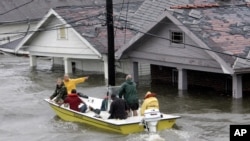When Hurricane Katrina pummeled the U.S. Gulf Coast on August 29, 2005, three states suffered major damage. The storm surge breached levees in New Orleans, causing 80 percent of the city to be flooded for weeks and destroying entire neighborhoods. In all, nearly 2,000 people were killed and 1 million were displaced.
The chaos after the hurricane was evident with a lack of coordination among political officials, relief organizations, the military and the Federal Emergency Management Agency, the disaster response arm of the U.S. government. People waiting to be rescued on rooftops and thousands seeking shelter in the New Orleans Superdome became symbols of the failure.
“Probably the biggest challenges occurred in the initial response,” said Craig Fugate, FEMA administrator since 2009, during an interview with VOA. “There was such a long process in making decisions that it was delaying things.”
“The trap we fell into was we prepared for what we were capable of doing, and we just hoped it would never be any worse,” added Fugate. "The theory was if it’s worse, then we’ll just scale up, and we found out scaling up didn’t work. So you have to prepare for how bad it’s going to be, or you’re going to fail. And I think that was the lesson we had to learn in all levels of government.”
Although FEMA was often given the blame, Fugate pointed out that initial emergency measures are directed by a state governor, whom FEMA then supports. Although FEMA still follows the governor’s lead, Fugate said, what has changed since Hurricane Katrina is that state and federal groups coordinate their efforts, including the military, search-and-rescue teams and engineers.
“So we’re not operating as distinct entities,” Fugate explained,” as much as we bring our resources together and work as a team to solve the problems.”
He said it also has helped that Congress gave FEMA more resources to deploy faster, and the authority to begin preparing ahead of a catastrophe — with food, water, generators and other resources — even before the governor has declared a major disaster.
“Our focus is on the speed of response, not waiting until states are overwhelmed, and not waiting until how bad something is before we start making decisions,” he said.
Fugate, who has been surveying the leftover damage from Katrina 10 years later, is concerned about rebuilding in the areas where the worst flooding hit. The key, he said, is to “build homes stronger and elevate them. But if you don’t make those changes, you’re going to see the same thing over and over again in future storms.”
As rebuilding continues in New Orleans, Fugate is confident the city will be able to withstand a severe storm and flooding.
“The city actually has stronger building codes than it had before Katrina,” including a requirement that houses “have to be lifted three feet higher than base flood elevation.”








